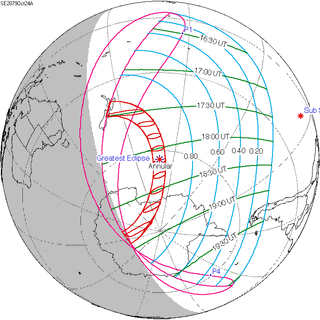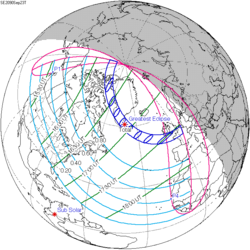Top Qs
Timeline
Chat
Perspective
Solar eclipse of October 24, 2079
Future annular solar eclipse From Wikipedia, the free encyclopedia
Remove ads
An annular solar eclipse will occur at the Moon's descending node of orbit on Tuesday, October 24, 2079,[1] with a magnitude of 0.9484. A solar eclipse occurs when the Moon passes between Earth and the Sun, thereby totally or partly obscuring the image of the Sun for a viewer on Earth. An annular solar eclipse occurs when the Moon's apparent diameter is smaller than the Sun's, blocking most of the Sun's light and causing the Sun to look like an annulus (ring). An annular eclipse appears as a partial eclipse over a region of the Earth thousands of kilometres wide. Occurring about 5.25 days before apogee (on October 29, 2079, at 23:40 UTC), the Moon's apparent diameter will be smaller.[2]
The path of annularity will be visible from parts of New Zealand and Antarctica. A partial solar eclipse will also be visible for parts of Oceania, Antarctica, and southern South America.
Remove ads
Eclipse details
Summarize
Perspective
Shown below are two tables displaying details about this particular solar eclipse. The first table outlines times at which the Moon's penumbra or umbra attains the specific parameter, and the second table describes various other parameters pertaining to this eclipse.[3]
Remove ads
Eclipse season
This eclipse is part of an eclipse season, a period, roughly every six months, when eclipses occur. Only two (or occasionally three) eclipse seasons occur each year, and each season lasts about 35 days and repeats just short of six months (173 days) later; thus two full eclipse seasons always occur each year. Either two or three eclipses happen each eclipse season. In the sequence below, each eclipse is separated by a fortnight.
Remove ads
Related eclipses
Eclipses in 2079
- A partial lunar eclipse on April 16.
- A total solar eclipse on May 1.
- A total lunar eclipse on October 10.
- An annular solar eclipse on October 24.
Metonic
- Preceded by: Solar eclipse of January 6, 2076
- Followed by: Solar eclipse of August 13, 2083
Tzolkinex
- Preceded by: Solar eclipse of September 12, 2072
- Followed by: Solar eclipse of December 6, 2086
Half-Saros
- Preceded by: Lunar eclipse of October 19, 2070
- Followed by: Lunar eclipse of October 30, 2088
Tritos
- Preceded by: Solar eclipse of November 24, 2068
- Followed by: Solar eclipse of September 23, 2090
Solar Saros 154
- Preceded by: Solar eclipse of October 13, 2061
- Followed by: Solar eclipse of November 4, 2097
Inex
- Preceded by: Solar eclipse of November 14, 2050
- Followed by: Solar eclipse of October 4, 2108
Triad
- Preceded by: Solar eclipse of December 24, 1992
- Followed by: Solar eclipse of August 25, 2166
Solar eclipses of 2076–2079
This eclipse is a member of a semester series. An eclipse in a semester series of solar eclipses repeats approximately every 177 days and 4 hours (a semester) at alternating nodes of the Moon's orbit.[4]
The partial solar eclipses on January 6, 2076 and July 1, 2076 occur in the previous lunar year eclipse set.
Saros 154
This eclipse is a part of Saros series 154, repeating every 18 years, 11 days, and containing 71 events. The series started with a partial solar eclipse on July 19, 1917. It contains annular eclipses from October 3, 2043, through March 27, 2332; hybrid eclipses from April 7, 2350 through April 29, 2386; and total eclipses from May 9, 2404 through May 29, 3035. The series ends at member 71 as a partial eclipse on August 25, 3179. Its eclipses are tabulated in three columns; every third eclipse in the same column is one exeligmos apart, so they all cast shadows over approximately the same parts of the Earth.
The longest duration of annularity will be produced by member 9 at 3 minutes, 41 seconds on October 13, 2061, and the longest duration of totality will be produced by member 35 at 4 minutes, 50 seconds on July 25, 2530. All eclipses in this series occur at the Moon’s descending node of orbit.[5]
Metonic series
The metonic series repeats eclipses every 19 years (6939.69 days), lasting about 5 cycles. Eclipses occur in nearly the same calendar date. In addition, the octon subseries repeats 1/5 of that or every 3.8 years (1387.94 days). All eclipses in this table occur at the Moon's descending node.
Tritos series
This eclipse is a part of a tritos cycle, repeating at alternating nodes every 135 synodic months (≈ 3986.63 days, or 11 years minus 1 month). Their appearance and longitude are irregular due to a lack of synchronization with the anomalistic month (period of perigee), but groupings of 3 tritos cycles (≈ 33 years minus 3 months) come close (≈ 434.044 anomalistic months), so eclipses are similar in these groupings.
The partial solar eclipses on December 18, 2188 (part of Saros 164) and November 18, 2199 (part of Saros 165) are also a part of this series but are not included in the table below.
Inex series
This eclipse is a part of the long period inex cycle, repeating at alternating nodes, every 358 synodic months (≈ 10,571.95 days, or 29 years minus 20 days). Their appearance and longitude are irregular due to a lack of synchronization with the anomalistic month (period of perigee). However, groupings of 3 inex cycles (≈ 87 years minus 2 months) comes close (≈ 1,151.02 anomalistic months), so eclipses are similar in these groupings.
Remove ads
References
External links
Wikiwand - on
Seamless Wikipedia browsing. On steroids.
Remove ads

























































































